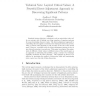Free Online Productivity Tools
i2Speak
i2Symbol
i2OCR
iTex2Img
iWeb2Print
iWeb2Shot
i2Type
iPdf2Split
iPdf2Merge
i2Bopomofo
i2Arabic
i2Style
i2Image
i2PDF
iLatex2Rtf
Sci2ools
115
Voted
ML
2008
ACM
2008
ACM
Layered critical values: a powerful direct-adjustment approach to discovering significant patterns
Standard pattern discovery techniques, such as association rules, suffer an extreme risk of finding very large numbers of spurious patterns for many knowledge discovery tasks. The direct-adjustment approach to controlling this risk applies a statistical test during the discovery process, using a critical value adjusted to take account of the size of the search space. However, a problem with the direct-adjustment strategy is that it may discard numerous true patterns. This paper investigates the assignment of different critical values to different areas of the search space as an approach to alleviating this problem, using a variant of a technique originally developed for other purposes. This approach is shown to be effective at increasing the number of discoveries while still maintaining strict control over the risk of false discoveries.
| Added | 13 Dec 2010 |
| Updated | 13 Dec 2010 |
| Type | Journal |
| Year | 2008 |
| Where | ML |
| Authors | Geoffrey I. Webb |
Comments (0)

